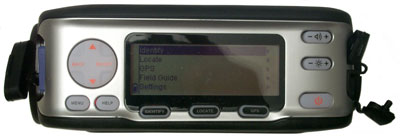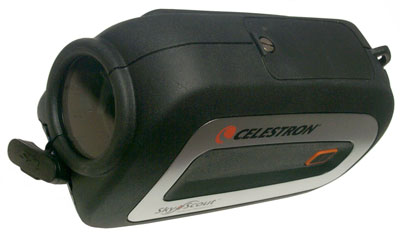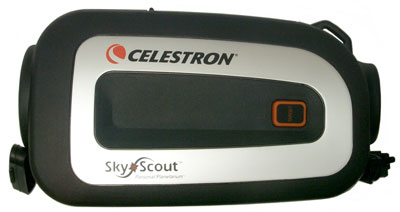Background
These are what I call orientation devices. That's to say they
have an accelerometer (ADXL320) to measure elevation angle and a
magnetic compass (Brand & Model?) to measure azimuth bearing
as well as a GPS (SiRF GSCI-4100) to know where on the Earth they are
and the current Universal Coordinated Time (UTC) and date.
A micro
controller (Samsung S3C2410) uses the sensor inputs with a data base
containing the locations of many heavenly bodies to either identify an
unknown object or to guide you to a desired object. They will not
work in a vehicle where there is acceleration but
should work in a vehicle going in a straight line at constant speed,
like on a freeway.
The optical path in the SkyScout and mySky is just a window.
There's no magnification. That's because many of the things you
want to see take up a large expanse of the sky and because it's hard to
hand hold anything with much magnification. There's no
point in magnifying the image of a star because it's still going to
look like just a point. It takes a lot of magnification to see
things like the Messier objects, i.e. a good telescope, not a drug
store type.
Celestron came out with the SkyScout and
Meade
with the mySky around 2002. In July 2009 while looking for
something else spotted a mySky for just over $100 so Googled it and
found there are a number of problems with the push buttons (fall off,
get stuck) and that some units just don't work at all. Then
Googled the Sky Scout and didn't find any chronic problems with
it. Net Shops had them on sale for $189 and also had the "All
About Stars" and "Astronomy for Beginners" memory cards for $20 each.
Digital Setting Circles
The setting circle on a telescope is just a dial calibrated in degrees or time
(declination/elevation) and (right ascension/azimuth). When the
scope is aligned you can then point to anything by just setting
it's coordinates. By adding angle encoders and an outboard box you end
up with Digital Setting Circles. By entering your location (Lat, Lon),
and the UTC time and date they can help you find any object in their
data base. You could for example use a pendulum hung from a pair of
binoculars to control the elevation encoder and a magnetic compass to
control the azimuth encoder and have something similar to the
orientation devices.
Operation
Identify
You point to something and press the Target button on the top. The LCD panel gives you the name.
Locate
You choose what you want to see and
when looking through the zero magnification (just glass windows) finder
there is a LED in one of 8 radial positions telling you which way to
move. When you're on target all the LED blink. If what you
are asking for is below the horizon the Sky Scout still will direct you
to it, i.e. pointing into the ground. I like that much better
than a no solution result because you can find objects that are just
about to rise or have just set.
Tonight's Highlights
Stars
Constellations
Deep Sky
Asterisms
GPS
Position and satellites items.
Field Guide
When one of the memory cards is plugged in it's title is the first entry.
Settings
Allows manual entry of date, time, Lon
& Lat (handy if GPS not available, like when indoors). Also
an "about" with the version numbers.
as received: Version: 1.28.12 Nov 15 2007
There is also a "Telescope Interface" item under the Settings menu.
SD Memory Card
The SD Memory card title appears after "Settings" in the main menu. It is not under Field Guide.
Help
There is a HELP button on the front
panel. For setting up the SkyScout, Identifying objects or
Locating objects from the data base.
Updates
The SkyScout PC program checks for a new PC software version of itself
and downloads that. Then checks for a new version of the SkyScout
firmware.
18 July 2009 SkyScout_013022EN.cel is the current firmware (1.28.12 is the as delivered firmware).
18 July 2009 version: 1.30.22 Jun 5 2008
Battery Sleeves
These are made of magnetic shielding
material and are not welded (would require a heat treat operation) just
wrapped. They can be made to fit a larger diameter AA cell by just
cutting the label to allow the metal to slide. If these are not
installed the magnetic compass will have what's called a hard iron
error and my be way off. I've heard that leaving the sleeves off
may also cause excessive current drain.
Cables
The SkyScout has a Mini-B size
USB connector that's used for firmware updates and connection to the Telescope Interface.
Celestron has NOT connected the USB DC power lines to the
SkyScout, but could since it does not seem to draw more than 500
ma. Why not?
The Speaker has a Micro-B size USB connector that's used to charge it's internal Li-xxx battery.
DC Power
At power on it draws about 200 ma.
When searching for GPS satelittes it draws almost 300 ma.
Accessories
All About Stars" SD memory card
"Astronomy for Beginners" SD memory card
External Speaker
Comes with a USB A to Micro-B cable for
charging the internal battery. A lanyard to hang around your
neck. A 3.5 mm stereo extension cable. The LED shows green
when the USB cable is connected and it turns red when the battery is
charged (maybe RED because you should disconnect the charging cable and
not leave it connected?) The LED is green when the Volume control
is on.
Holder for Green Laser Pointer - poor design, long screws get snagged
Telescope Interface -$99 allows connecting to Clelesron "go to"
scope and points scope at object viewed in Sky Scout. Maybe it's
a way to get the bearing and elevation angles out?
Note: When the SkyScout is
powered on and connected to a computer using a mini USB cable you can
see "SkyScout" in the Device Manager under USB devices. But is
does NOT show up as a hard drive.
The PC program "Celestron SkyScout" has it's own USB driver for talking to the SkyScout.
On Line Support
Patents
7155833 Viewing and display apparatus position determination algorithms, Lemp, III; Michael (Irvine, CA),
Yamcon, Inc. (Rancho Santa Margarita, CA), January 2, 2007, 33/268 ; 33/355R; 33/366.11; 340/815.4; 434/284
7010862 Viewing and display apparatus position determination algorithms, Lemp, III; Michael (Irvine, CA),
Yamcon, Inc. (Irvine, CA), March 14, 2006 33/268 ; 33/355R; 33/366.11; 340/815.4; 434/284
6844822 Celestial object location device, Lemp, III; Michael (Aliso Viejo, CA),
Yamcon, Inc. (Aliso Viejo, CA) January 18, 2005, 340/815.4 ; 33/628; 340/999; 701/13; 701/226
6570506 Celestial object location device, Lemp, III; Michael (Aliso Viejo, CA),
Yamcon, May 27, 2003, 340/815.4 ; 33/628; 340/907; 340/999; 701/13; 701/226
6366212 Celestial object location device, Lemp; Michael (Aliso Viejo, CA),
Yamcon, Inc. (Aliso Viejo, CA), April 2, 2002, 340/815.4 ; 33/268; 340/999; 701/13; 701/226
Links
Brooke's PRC68, Products for Sale, Personal Home Page
This is the [an error occurred while processing this directive] page created 18 July 2009.







